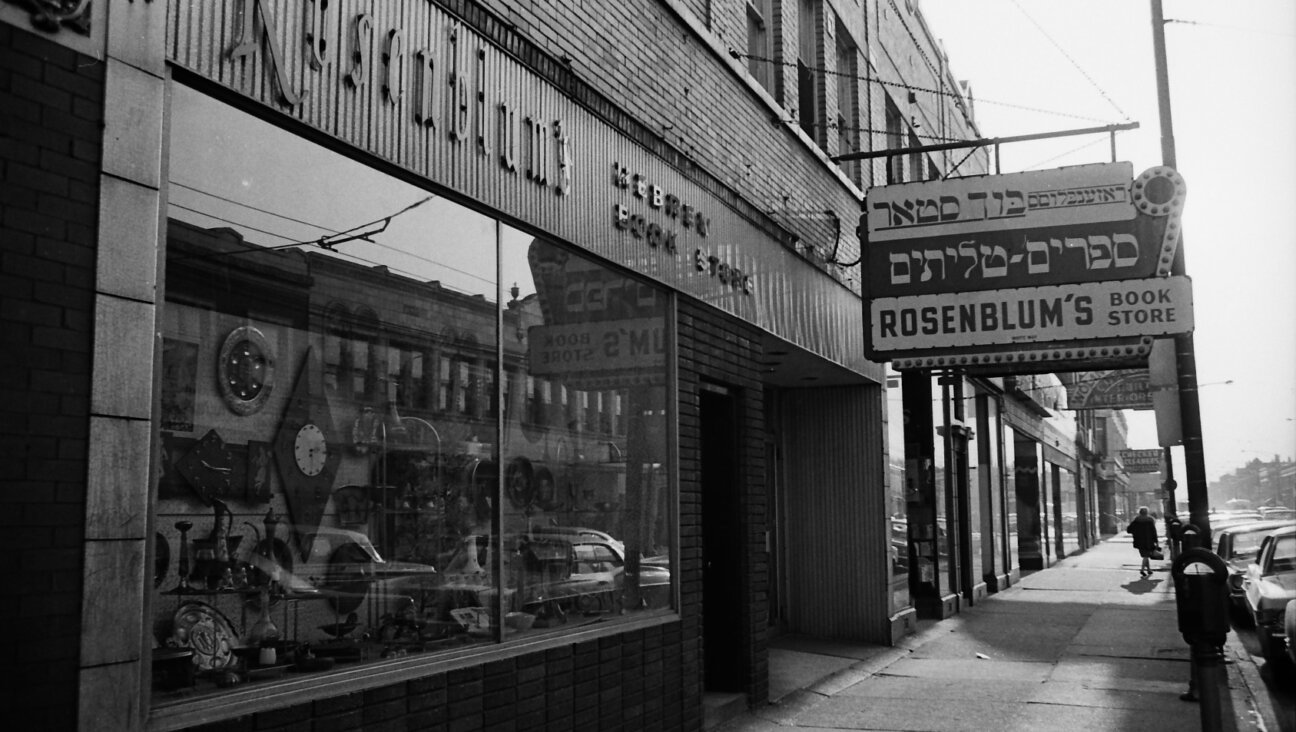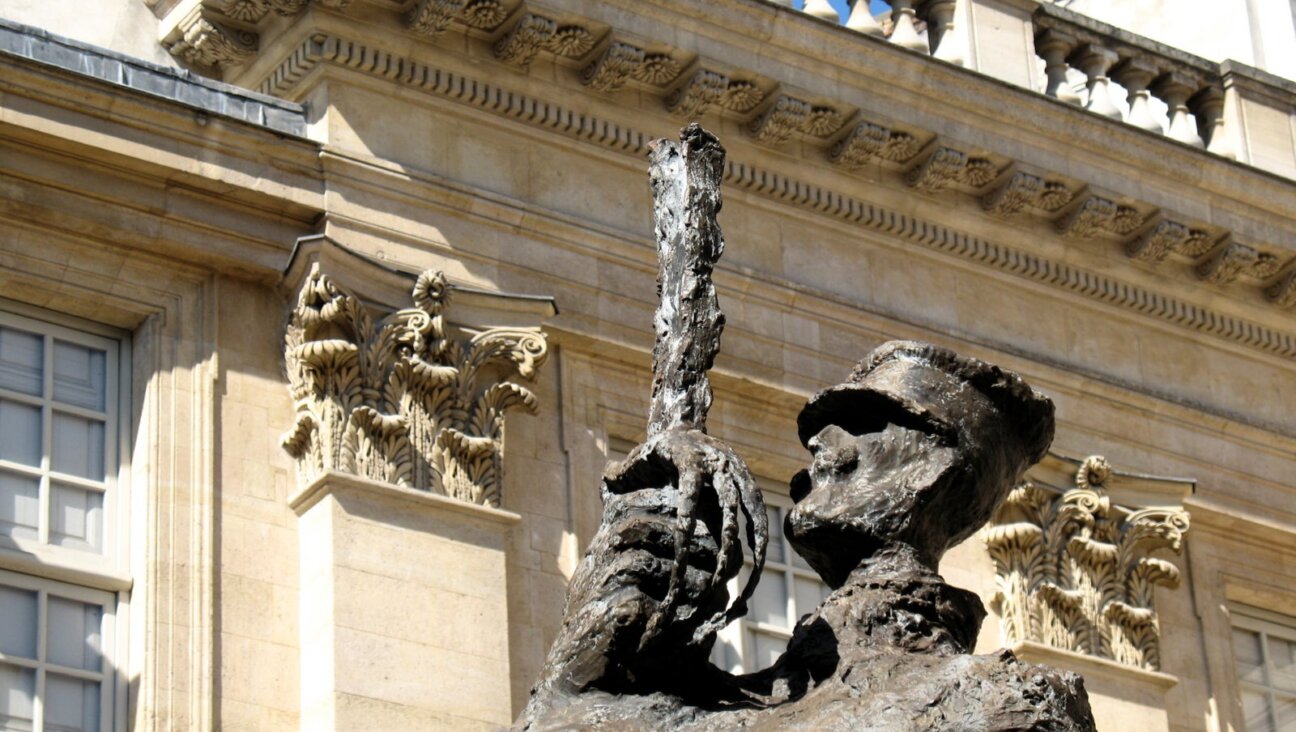Baseball’s Jewiest Moment of All

Image by Baseball Hall of Fame
In the top of the ninth inning of a game at Detroit’s Briggs Stadium between the Philadelphia Athletics and the Detroit Tigers on May 2, 1951, things looked bleak for the A’s. They trailed, 3-1, they had a runner on first base, and there were two outs.
Manager Jimmy Dykes summoned Lou Limmer to pinch-hit for light -hitting third baseman Billy Hitchcock. Dykes, no doubt, was hoping his slugging rookie Jewish first baseman from the Bronx would tie the game with one swing.
Awaiting Limmer on the mound was big Saul Rogovin, the Tigers’ 6’2”, 200-pound Brooklyn-born-and-bred Jewish hurler whose face expressed equal parts of solemnity, mournfulness, and soul. Joe Ginsberg, the Tigers’ Manhattan-born Jewish catcher, was behind the plate.
Limmer, with a face that conveyed earnestness and sincerity, had reason to like his chances. Just a day earlier against these same Tigers, Lou — again pinch- hitting for Hitchcock — had cracked an 11th- inning, bases- loaded pinch-hit double to bust up a 1-1 pitchers’ duel and spark a 9-1 A’s win. Just over a week earlier, in his second major- league at- bat and first Yankee Stadium at-bat, Lou had slammed a ninth- inning pinch- hit homer off the Yankees’ All-Star pitcher, Vic Raschi. And now, Rogovin was weakening, having yielded the A’s’ first hit of the game in the seventh inning, then surrendering two more hits and the Athletics’ lone run in the eighth.
Could the Tigers’ big right-hander hold on for one more out?
As Lou neared the batter’s box, the home plate umpire stepped out from behind the plate to dust off the dish. Then, as Limmer would recall years later, the ump said to him, “Boy, now I’ve got the three Hebes. I wonder who’s going to win the battle?”
The umpire’s remark may have been a good-natured jab at the shared heritage of Limmer, Rogovin and Ginsberg. Or it may have been tinged with a less innocent undercurrent. In any case, the remark called attention to the fact that at that moment, the three men gathered at the epicenter of the baseball universe —pitcher, catcher and batter — were all Jews. Neither before nor since that moment had or has such a gathering occurred in major league baseball history.
Given the paucity of Jewish major leaguers over the decades, this is not surprising. Of the roughly 17,000 players in major league history, fewer than one percent of them, or about 160, were or are Jewish.
Yet despite such microscopic Jewish representation in the big leagues — or maybe because of it — those few Jews who have reached the majors have been a source of enormous pride in the American Jewish community. Limmer’s own father provides a great example of such pride. Lou recalled a time when he and his father were listening to a Detroit Tigers game on the radio and heard Hank Greenberg’s name. “Is he Jewish?” Charles Limmer asked his son. “Yeah,” Lou replied. “Then I like the Tigers,” Charles Limmer said.
Jewish ballplayers were and are a living, breathing rebuttal to the stereotype that Jews are incapable of excellence in physical endeavors such as athletics. The greatest Jewish hitter, Hall of Famer Hank Greenberg, nearly broke Babe Ruth’s record of 60 home runs in a season. The greatest Jewish pitcher, Hall of Famer Sandy Koufax, may have been the greatest pitcher, period.
Lou Limmer, Saul Rogovin, and Joe Ginsberg were not nearly as gifted as Greenberg and Koufax. But in their own individual journeys to and through the world of professional baseball — a world that could be unwelcoming to the Jewish ballplayer — they made their own valuable contributions to the American Jewish experience and community.
Lou Limmer began his professional baseball career in 1946 with the Athletics’ Class D minor league affiliate in Lexington, North Carolina, a place where signs posted on roads and train tracks warning “Jews, Niggers and Dogs stay out” were quite a shock for the youngest of 12 children from a strictly Orthodox, strictly kosher Bronx home. It’s no wonder that Lou could not find a local synagogue to attend. He had better luck finding the ball park, where he hit .313 in 40 games that season.
Over the next four full seasons — one more in Lexington, two in A League ball in Lincoln, Nebraska, and one in Triple A ball in St. Paul, Minnesota — Lou batted.301and averaged 26 homers a season. “I’ll tell ya, that son of a gun could really hit,” said 89-year-old former pitcher Bobby Shantz, Lou’s teammate in Lincoln who would win the 1952 American League Most Valuable Player. Lou’s performance was all the more impressive given the broken neck he suffered while sliding into third base one day in 1949 that left him temporarily blinded and paralyzed and sidelined for about a month.
The A’s signed Lou in January, 1951 and seemed inclined to trade their incumbent first baseman, Ferris Fain, to make room for him. “The stylish left-hander is easily the healthiest young hitting prospect to grace the Athletics’ roster since the rookie days of Sam Chapman,” Hall of Fame sportswriter Joe Reichler wrote, comparing Lou to the long-time A’s star outfielder. In spring training in ’51, Lou — whom Furman Bisher, another Hall of Fame sportswriter, described as “the Jewish tyro” — had Ted Williams, arguably baseball’s greatest hitter ever, gushing about Lou’s prospects.
Limmer easily made the A’s out of spring training in ‘51, but the club decided to keep Fain, and the 26-year-old rookie who had torn up the minor leagues was suddenly a bench warmer. “He was put in a situation where he never was before, which was to pinch hit,” Dan Limmer, one of Lou’s two sons, told me. “And in his first year he just let himself get out of shape.”
It’s not clear whether anti-Semitism played a role in Limmer’s benching, and to be fair, Fain was an established star. Still, there were some distressing covert signs. “[Limmer] did overhear [A’s manager Jimmy Dykes] and other players talk about, you know, let’s sit his ass on the bench and see what he can do,” Dan Limmer said. “He heard these things but he felt he’d let his bat do the talking.” Dykes was a notorious bench jockey who some years earlier as manager of the White Sox had led his team in vicious heckling of Hank Greenberg that included someone from the Sox dugout calling Greenberg “a yellow Jew bastard.”
“When it comes to Jewish ballplayers, I don’t care what team you’re on, somewhere along the line there’s anti-Semitism,” Lou said later. A’s outfielder Dave Philley so tormented Lou that one day, the usually mild-mannered Limmer was about to let his fists, rather than his bat, do the talking. But Lou’s veteran teammate, Allie Clark, spared the rookie the task, decking Philley himself.
Lou got a chance to play in the middle of the ’51 season when Fain injured his toe. But a poorly conditioned Limmer didn’t hit, and Fain reclaimed his position when his injury healed. Still, Lou had his moments in ’51: his pinch homer of Vic Raschi in Yankee Stadium, belted in front of his family, a moment he would call his most exciting in baseball; his pinch double against Detroit on May 1 to key an A’s victory.
Unfortunately, there were not enough such moments to keep Lou in Philadelphia. He spent the 1952 and 1953 seasons at Philadelphia’s Triple A affiliate in Ottawa, where his slugging earned him a return to the A’s for the ’54 season. But once back in Philadelphia, at least to start, it was a reprise of ’51 — Lou was trapped on the bench. In mid-season, with regular first baseman Don Bollweg faltering, Lou got his chance, and this time he was ready. Lou had a number of big games and hit 14 homers for the season, one behind the team leader. Lou also authored some memorable moments in Athletics history as the financially troubled team completed its last year in Philadelphia and prepared to move to Kansas City: He had the last grand slam in the A’s ballpark, Connie Mack Stadium; the last pinch hit in team history; and the last home run in team history — fittingly enough, for the Bronx native, in Yankee Stadium.
Lou’s solid finish in ’54 and his eight homers in the ensuing spring training had him excited about the ’55 season. “He thought he had a lock [on first base],” Dan Limmer said. Instead, as Lou recalled later, “They sent me to the minors and I was devastated.” Lou endured another four years of minor league ball; when the majors didn’t call him up after a 30- home run season in Birmingham in 1958, it was time to settle down with his wife, Pearl, and his two sons, Craig and Dan. He returned home and worked in the commercial refrigeration business, first in his brother’s company and then for more than 30 years in his own company, before retiring.
The man who made it his business to find a synagogue to attend in every town he played in helped establish the Castle Hill Jewish Center, in the Bronx neighborhood where the Limmers lived for a time, and he served as the temple’s president for five years. He loved to regale school kids with stories of his nomadic baseball existence. His displeasure with the A’s’ treatment of him did not keep him from enthusiastically participating in Philadelphia Athletics Historical Society events. “This guy was one gentleman,” Lou’s Birmingham teammate, Frank Kastro, remembered.
“He had a pollyana attitude about life,” Limmer’s son Dan said. In 1998, Lou told an interviewer who had complimented him on his minor league statistics: “If they gave me a chance to play I would have done it in the major leagues. If you asked the fellows I played with in the minors they would tell you the same thing.”
In 1951, Saul Rogovin led Hall of Famers Bob Feller, Warren Spahn, and every other American and National League pitcher in earned run average, earning himself the unofficial title of “most effective” pitcher in baseball.
But, “If he were here right now, if he were sitting with us right now,” said author Leonard Kriegel, Saul’s friend, “he would tell you what a great hitter he was.”
Pitchers do like to brag about their hitting prowess, which is usually imagined rather than real, but Saul really could handle the bat. Rogovin grew up in a “not very religious” Brooklyn Jewish home and was reportedly too shy to be bar mitzvahed. He brought his Lincoln High team the New York City championship with a game-winning homer. It was then off to pro ball — no college, despite his parents’ wishes. In his first three minor league seasons, 1941,1944, and 1945, Saul, playing mostly as a third baseman, hit in the .280-.290 range and showed occasional home run power.
But with the war ending and a slew of major league veterans returning home to reclaim their jobs, Saul felt his best chance to reach the majors was as a pitcher. The transformation began in earnest in 1947 when Buffalo, the Detroit Tigers’ Triple A affiliate , signed Saul. Buffalo manager Paul Richards took special interest in Rogovin and began developing the raw hurler into a pitcher. Saul went 13-8 in 1948, and the Tigers called him up to the big club in April of 1949. But Saul’s stay was short-lived, 5 and 2/3 innings, to be exact. He wasn’t ready, and the Tigers sent Saul back to Buffalo.
Saul won 16 games in Buffalo in 1949, and was back in Detroit for the 1950 season. But he overextended himself on a cold spring night in an exhibition game and hurt his arm. Saul stayed with the team into August, but appeared in only 11 games. The highlight of Saul’s season came courtesy of his bat, not his arm: He slugged a grand slam against the Yankees in Yankee Stadium on July 23 — the last major league grand slam by a Jewish pitcher for 58 years.
Saul’s arm improved in the offseason, but early in the 1951 season, Detroit traded him to the White Sox, who were managed by Saul’s old friend Paul Richards. Not surprisingly, Saul immediately took to his new surroundings; a two-hit victory over St. Louis and a complete game shutout over Ted Williams’ Red Sox catapulted Saul to a 12-8 season record and his major league-best 2.78 ERA “I really was at the top of the world,” Saul would say years later about his ERA title.
Rogovin pitched brilliantly again in 1952, posting a 14-9 record and a 3.85 ERA.
All-Star first baseman Eddie Robinson was the hitting star of those ’51 and ’52 White Sox teams. The 94-year-young Robinson, commenting on Rogovin’s pitching some 63 years later, remembered Saul as a “fearless” pitcher who “wasn’t afraid to throw any of his pitches.” “He had just average stuff,” Robinson said. “Maybe a little below average fastball. But Paul Richards worked with him, and he and Saul got along great, and Saul pitched well for Chicago when I was there.”
The American League’s most valuable player in 1952, Athletics pitcher Bobby Shantz, had similar recollections. “I watched him pitch a few times and he was a good pitcher,” Shantz said. “Saul never threw real hard but he had good control and he changed speeds really good.” His windup — arms and legs flailing everywhere like a broken windmill — may have kept batters a bit off-balance.
Saul couldn’t have known it then, but the 1952 season would be his career’s zenith. He plummeted to a 7-12 record in 1953, and Chicago let him go. It was back to the minors in ’54, followed by disaster in the first part of ’55 — a 1-8 record for Baltimore. Rogovin enjoyed somewhat of a resurgence with the Phillies in the latter part of the 1955 season and in 1956, including a stretch over two consecutive starts when he retired 32 straight batters (including Hall of Famers Stan Musial and Ernie Banks) without allowing a baserunner. There cannot be too many other pitchers, Jewish or not, who have ever done that in the big leagues.
But the heady days of ’51 and ’52 were gone forever. It’s not clear why. There was some more arm trouble. Saul had an unusual penchant for falling asleep in the dugout during games, and there was tension with some teammates who construed this behavior as laziness or indifference. Sixty-three years after playing with Rogovin on the White Sox, 89-year-old Howie Judson still spoke of Saul’s odd habit in a tone of voice that sounded somewhere between annoyed and angry. Neither Judson nor Saul’s other teammates nor Saul himself realized during Saul’s playing days that he was suffering from undiagnosed narcolepsy.
Self-inflicted tension borne of a burning desire to succeed in the majors also may have contributed to Saul’s decline. Years after his playing days, Saul said: “I enjoyed the game more in the minors many times than in the big leagues. I felt a lot more pressure in the big leagues, the fun wasn’t there.”
Saul also felt constant pressure being a Jew in an overwhelmingly non-Jewish game. “When he encountered anti-Semitism in the bigs, it…would get him crazy ‘cause it was…covert,” Saul’s friend Len Kriegel said. “ You never knew who the hell said it from the other side.” The religious prejudice created a painful internal isolation.
Years after his playing days, Saul reflected: “…I felt like the outsider as a Jew. I didn’t feel like one of [my teammates], basically. Deep down inside I never felt like I was accepted, I never felt accepted, whatever accepted was…this was an inward feeling, a deep, gut feeling that I was a Jew and a Jew is oppressed, a Jew is always oppressed. Be on your guard because basically no one likes Jews…[This was a] really lonely, very lonely feeling.”
Saul retired after the 1957 season, the bulk of which he spent in the minors trying to resuscitate his faded career. After working unhappily as a liquor salesman for a while, 51-year-old Saul Rogovin enrolled in Manhattan Community College and then City College (where his friend Len Kriegel was one of his professors) to become a school teacher. Saul found fulfillment in this 12-year-long second career as an English and literature teacher helping underprivileged high school kids growing up in some rough New York City neighborhoods. He was “a man for all seasons,” Saul’s wife Evelyn said, fondly recalling Saul’s teaching career. Many of the kids really took to their old teacher who used to be a major league baseball player. One such kid was a star pitcher for the school baseball team named Francisco Rodriguez, who went on to pitch in the big leagues for seven seasons.
Saul was inducted into the National Jewish Sports Hall of Fame in 1998.
Like Limmer and Rogovin, Joe Ginsberg bounced around the minor leagues quite a bit. But unlike Limmer, Ginsberg also enjoyed a long major league career, managing to play all or part of 13 major league seasons on the strength of skill and toughness as a catcher, despite being somewhat small for the position at 5’11”and 180 pounds.
“He was quite a good defensive catcher,” 82-year-old former pitcher Billy O’Dell said as he reflected on his Baltimore Orioles teammate. “He was a little slow with the bat, but he was a good defensive catcher. I liked to pitch to him.” That is high praise from a hurler who won 105 games and fashioned a 3.29 earned run average over 13 seasons. Milt Pappas, another Orioles pitcher, who won 209 games in 17 major league seasons, concurred. “Actually he was a pretty good catcher, the 75-year-old Pappas said. “He wouldn’t be there if he weren’t.”
Starting with the Tigers in 1948 and ending with the Mets in 1962, Joe played for seven different big league teams — proof that a team always has room for a quality reserve catcher. Years after his playing days, Joe explained his positive view of his nomadic major league existence by relating a conversation he had with former major leaguer Dick Littlefield, who played for 10 different teams. “I liked to talk to Dick about that,” Ginsberg recalled. “I’d say, ‘Dick, you know it’s not that nobody wanted us. It’s that everybody wanted us.’ I liked to think that.”
That kind of positive thinking was in line with Joe’s overall personality. “Joe was very jovial,” Milt Pappas recalled. “You know, he was always upbeat. He was always ready to go.”
Myron Nathan “Joe” Ginsberg was born in Manhattan in 1926 to parents he never knew. A Jewish couple, the Ginsbergs, adopted him about two months after he was born and moved with their son to Detroit. Joe grew up in a Jewish household and had a bar mitzvah, but he maintained that he “was never really religious.”
But Joe’s modest level of observance did not, and could not, spare a professional baseball player named Joe Ginsberg from religious bigotry. “You can’t miss it,” Joe said many years after his playing days when asked if he experienced anti-Semitism. “ You hear it once in a while coming out of the stands. Even the ballplayers will once in a while say something about Jews and this and that, but you just got to let the water run off your back. You can’t be the kind of guy who wants to fight all the time if they say something about your religion…There’s always anti-Semitism around, and you’re going to hear it.”
According to Jackie Hiatt, Joe’s first wife, Joe said that when he played for Detroit, he even heard it from Tigers’ owner Walter O. Briggs. “One time [Ginsberg] was standing in the batting circle and Old Man Briggs said, ‘Sit down, Jewboy,’ or something to that effect,” Hiatt recalled.
Despite a pedestrian career, Ginsberg, like Limmer, had his moments. Joe victimized Yankee great Vic Raschi at Yankee Stadium, slamming a two-out eighth inning homer to spoil Raschi’s no-hit bid in 1952. Also in 1952, Joe caught the first of Tigers’ star pitcher Virgil Trucks’ two no-hitters that year. In his years with the Baltimore Orioles, Joe, usually the reserve catcher, was often selected to catch Hall of Famer Hoyt Wilhelm because he could catch Wilhelm’s seemingly uncatchable knuckleball better than anyone.
And there was Joe, as a Red Sox player, witnessing Roger Maris’ 61st homer in 1961, and, as an original New York Met, catching their first-ever home game, in 1962.The Mets had signed the 35-year-old Ginsberg to guide their younger players and there was no prospect of much playing time for him. But Casey Stengel, managing the Mets in his final baseball act, rewarded Joe for his 13 big league years by honoring him with the start in the home opener. Unfortunately, Joe, at best a modest hitter throughout his career, went hitless in four at-bats. After one more hitless at-bat two days later, the Mets released him.
After baseball, Joe worked for a while as a salesman for the Jack Daniels distillery and then retired to a life of golf and baseball fantasy camps in Florida. He was inducted into the Michigan Jewish Sports Foundation Hall of Fame in 1995.
Lou Limmer passed away in 2007 at the age of 82. Saul Rogovin left us in 1995, at the age of 72. Joe Ginsberg passed in 2012 at the age of 86.
In Lou Limmer’s two major league seasons, he batted .202 with 19 home runs. Joe Ginsberg batted .241 with 20 homers over 13 major league seasons. Saul Rogovin was 48-48 with a 4.06 earned run average over his eight major league seasons.
No, Limmer, Rogovin and Ginsberg weren’t Hank Greenberg and Sandy Koufax. But individually, they each had their own praiseworthy lives and accomplishments as Jewish big leaguers.
And collectively, they had their unique gathering in Briggs Stadium on May 2, 1951…
With Lou Limmer ready in the batters’ box, Saul Rogovin trained his droopy eyes on Joe Ginsberg’s glove, launched into his crazy pitching motion, and fired the first pitch.
Limmer swung as the ball neared the plate. Ginsberg reached for the ball and squeezed his glove but caught only air as Lou slammed the ball into the right field stands for a game-tying home run.
“I guess you’re the winner, Lou,” the umpire said as Limmer crossed the plate.
But years later, Lou didn’t see it that way. “It so happens,” Lou said, “ I wasn’t [the winner], because Joe Ginsberg stayed with Detroit and Saul Rogovin went to the White Sox that year and he led the league in E.R.A. and poor Lou Limmer, he got shipped to the minors.”






















